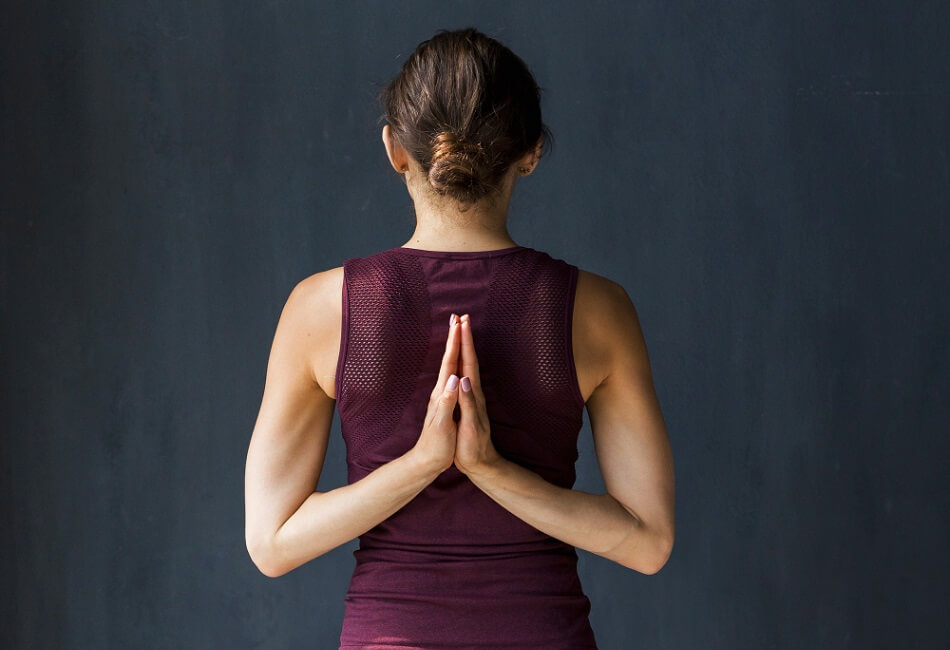
In the realm of yoga, each asana carries a unique essence that resonates with the body, mind, and spirit. One such captivating pose is Paschim Namaskarasana, also known as the Reverse Prayer Pose. This elegant and introspective posture not only enhances physical flexibility but also cultivates a profound sense of balance and mindfulness. In this article, we delve into the meaning, steps, and myriad benefits of Paschim Namaskarasana, inviting practitioners to embark on a journey of self-discovery and well-being.
The Essence of Paschim Namaskarasana:
“Paschim” signifies the back or the west, while “Namaskara” denotes a gesture of reverence or salutation. Paschim Namaskarasana, or the Reverse Prayer Pose, embodies a melding of the physical and spiritual, uniting the art of movement with the grace of introspection. The pose involves bringing the hands together in prayer behind the back, creating a gesture that exudes poise and reverence.
Steps to Attain Paschim Namaskarasana:
1. Begin in a comfortable seated position, preferably on a yoga mat or cushion.
2. Extend both legs in front of you, keeping them straight and active.
3. Inhale deeply, elongating the spine, and exhale as you gently draw the shoulder blades back and down.
4. Bend your elbows, bringing the palms of your hands together in prayer position behind your back. Fingers point upwards.
5. Press the palms firmly together, engaging the chest muscles and creating a gentle stretch across the shoulders and chest.
6. Maintain a tall and erect posture, lengthening the spine while keeping the abdomen gently engaged.
7. Breathe deeply and hold the pose for several breaths, focusing on alignment and a sense of inner calm.
8. To release, slowly exhale as you lower the hands back to your sides, returning to a neutral seated position.
Benefits of Paschim Namaskarasana:
1. Enhanced Upper Body Flexibility: The pose provides a deep stretch to the shoulders, pectoral muscles, and biceps, promoting increased mobility and flexibility.
2. Improved Posture: Paschim Namaskarasana gently stretches the thoracic region and spine, helping to alleviate tension and encouraging better posture.
3. Balanced Energy Flow: The pose stimulates the heart chakra (Anahata), fostering emotional equilibrium and self-compassion.
4. Mindful Awareness: Practicing the Reverse Prayer Pose demands concentration and mindfulness, offering a serene escape from daily distractions.
5. Strengthened Core: Engaging the core muscles while holding the pose contributes to improved stability and balance.
6. Deeper Breathing: Paschim Namaskarasana encourages diaphragmatic breathing, enhancing lung capacity and promoting relaxation.
Precautions and Modifications:
As with any yoga practice, it’s essential to approach Paschim Namaskarasana mindfully. Individuals with wrist, shoulder, or lower back issues should exercise caution or seek guidance from a qualified instructor. Props such as a strap can be utilized to assist in achieving the full expression of the pose.
Paschim Namaskarasana, the Reverse Prayer Pose, beckons practitioners to explore the harmonious convergence of physical alignment and spiritual connection. Through its graceful stance and meaningful gesture, this pose invites individuals to cultivate flexibility, balance, and mindful awareness. As we embrace Paschim Namaskarasana, we embark on a journey that unites body, breath, and spirit, guiding us toward a state of holistic well-being and self-discovery.










































